I want to help you build a sustainable, profitable handmade business that makes you consistent income and sales. I only ever teach or recommend marketing, social media, pricing, production and branding tips that I’ve personally used successfully in my own 7-figure handmade businesses.
I'm Mei, from Los Angeles!
Read More
Popular Posts You'll Love
Looking for something?
Categories
starting a business
get more traffic
running a business
make more sales
branding
growing a business
mindset & productivity
podcasts
pricing & money
product photography
reviews
selling on etsy
selling on amazon
social media
selling wholesale
- Facebook1
- Twitter4
- Pinterest21
- 26shares
Do Amazon ads work and should you be using them to make more money from your handmade business?
Today, I’m going to explain how Amazon Advertising works, and how you can start using it to make more money from your handmade business.
First, you may be wondering what Amazon Advertising is and whether you even need it to be successful.
So let’s get into that first.
So Amazon is the largest ecommerce search engine in the world. Although Google remains the top search engine in general, last year, Amazon came away with around 50% of the US ecommerce market. So when you’re thinking about online advertising strategies, you’d be insane not to consider Amazon’s huge customer base!
Now, Amazon has a few advertising programs to choose from, but the best one to get started with (and the one I’ll be showing you in today’s video) is Amazon’s Sponsored Product Ads.
Amazon Sponsored Products
If you’re familiar with Google AdWords, Amazon Sponsored Product Ads are very similar. When you type keywords into the Amazon search bar, some of the results will show up on the very top of the page and actually look just like regular product listings. The difference is that they’re marked with a tiny label that says “sponsored” or “ad”.
Those are sponsored product ads, and if you want to gain more visibility on Amazon, you can pay for these premium positions by bidding on specific keywords.
The good thing is that you only pay for performance. So you’re never charged unless a customer clicks on your ad, and you always control how much you’re willing to spend for a click.
This is called PPC advertising, which is short for “Pay-Per-Click”.
I know, you’re probably thinking: “I’m only getting started on Amazon and there’s so much competition on there already! Won’t ads cost me a fortune?”
Well, consider that people on Amazon are already in the mood to buy something when compared to someone who’s just searching for answers on Google or scrolling through their Facebook newsfeed. They’re already halfway down your marketing funnel and have what you’d call a much higher buyer-intent.
Another reason you may want to look into Amazon ads is that simply setting up a store may not be enough to get your business going.
Sure, there are ways to grow organically, but with so many sellers competing to sell similar products, you probably won’t get the exposure you need to generate a ton of sales as quickly as you’d like.
So if you’d like to start selling on Amazon as fast as possible, you may want to understand how to use Amazon advertising, and that’s what I’m going to show you today.
Now, you don’t have to be a marketing genius to run profitable ads on Amazon. There are really only two principles you need to keep in mind when it comes to running ads.
1. Make Sure You Have Enough Profit Margin on the Product You’re Selling
This is important, otherwise, the ad costs will chew up your margins and you won’t make any money at all.
If you’re not sure how you should be pricing your handmade products, you can check out one of my other videos linked here, where I guide you through the exact process I use to set my prices. If you use my formula, you’ll be set and ready to do ads.
Assuming you’ve already got a price for your product, here’s how to figure out your profit margins for Amazon: Let’s say you’re selling a cupcake necklace for $30, which cost you $5 to make. You’ll then want to subtract about 20% to account for Amazon’s service and fulfillment fees. In our case that’s exactly $6, leaving us with a remaining $19.
That means, you can spend up to $19 to make a sale on Amazon and break even. So say it cost you $8 in ads to make a sale, you would ultimately be profiting $11 for selling one cupcake necklace.
That’s a 37% profit margin, which is considered healthy.
2. Data is Everything
What I mean is that ads work like research. You may get lucky on your first try, but you’ll typically need to run a few campaigns to gather some initial data and continue to tweak your settings until you start honing in on the keywords that get you the most profit.
You won’t get rich overnight, but as long as you’re making sales and keeping up with the process, you’ll eventually lock in on the perfect keywords for your audience.
Alright, so now I’m going to show you how to set up your first ad campaign for our cupcake necklace over on Amazon.
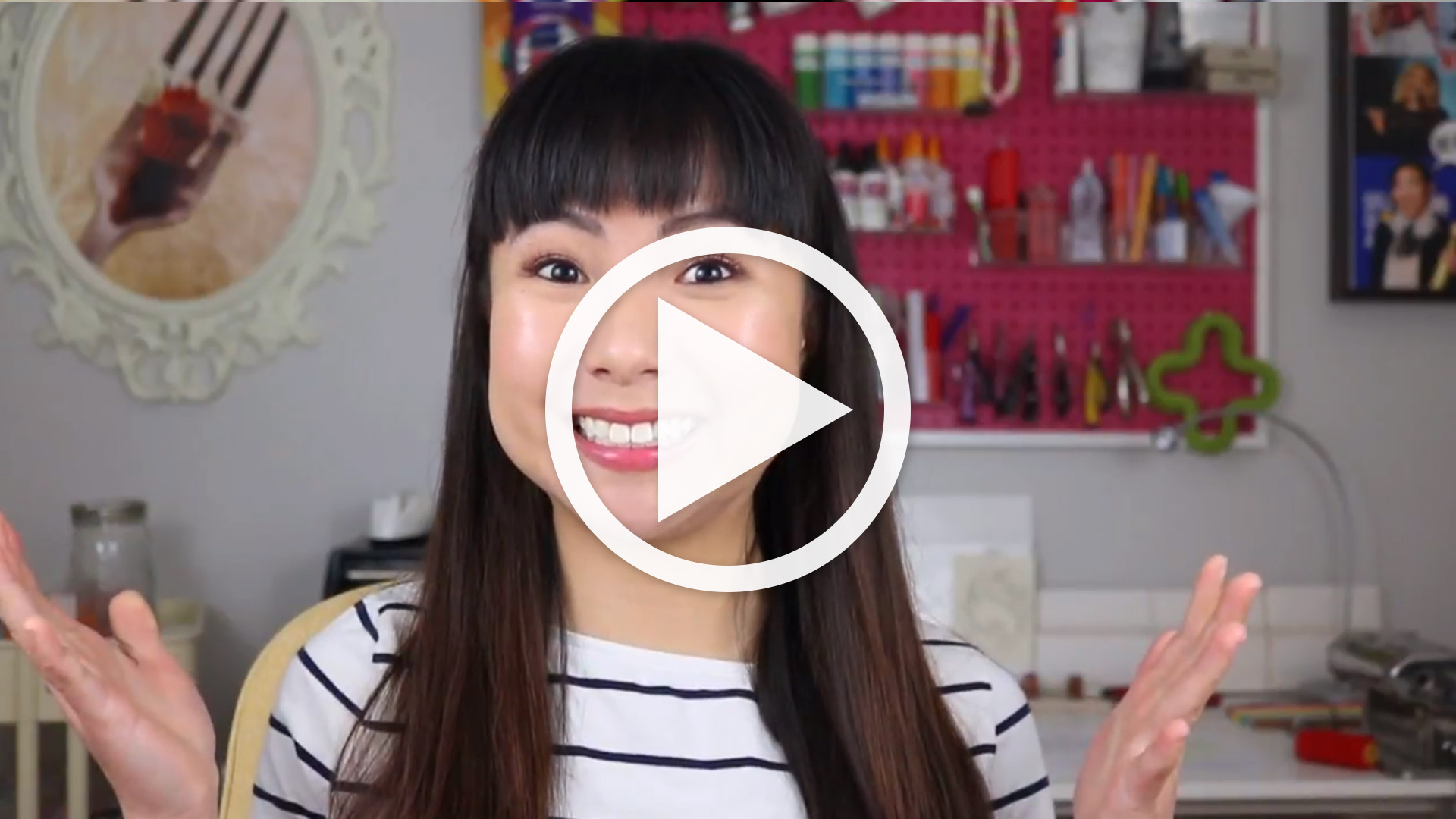
Setting Up Your Campaign
Once you’ve logged into your Amazon seller account, click on the menu, then head over to “advertising” and click on “campaign manager”, where you will see the option to create a new campaign.
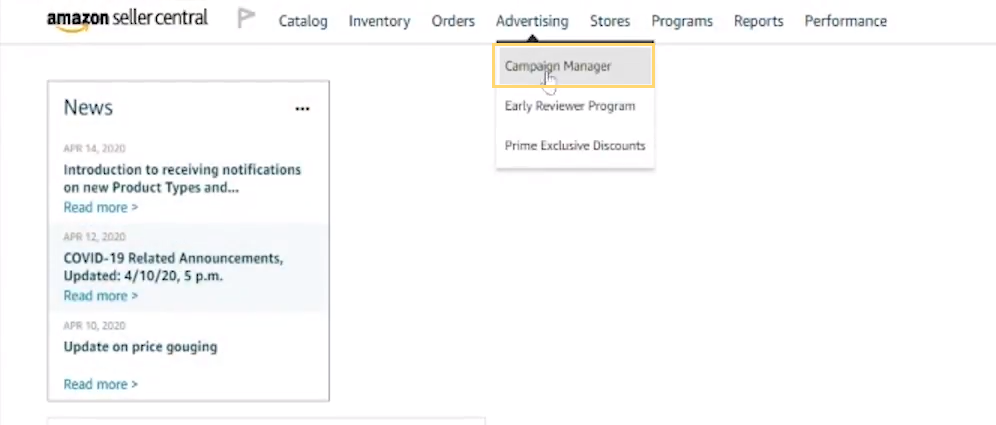
As I mentioned, we’re going to be focusing on “sponsored products” because these are the most cost-effective when first starting out.
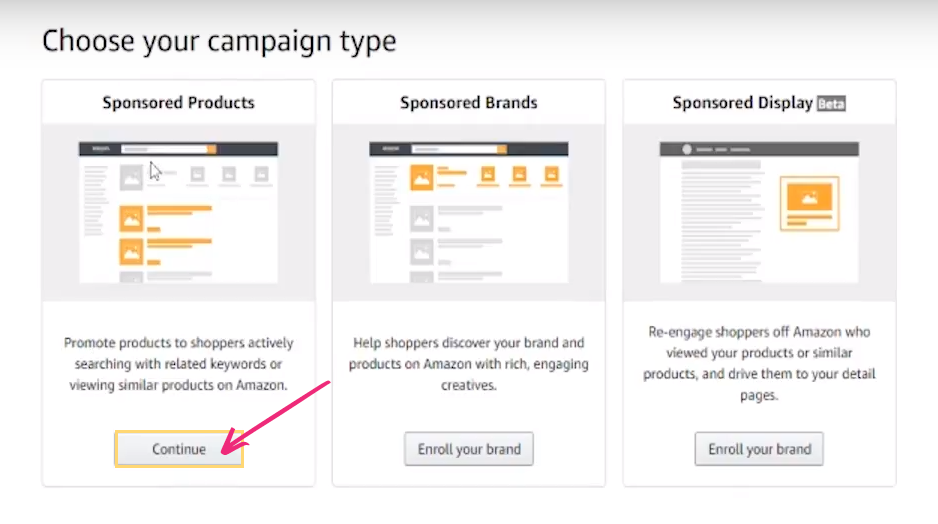
Click on “continue”. Next, it’s going to ask you for your campaign name. This is where you want to enter your product name. I’m just going to type “cupcake necklace”.
For start date, you can select tomorrow and you can just leave the end date blank, because you’ll always have the access to stop your campaign at any time.
For your daily budget, I recommend starting off with anywhere from 5-10 dollars. I’m going to go for 10.
Next, you’ll want to select automatic targeting. This is the best way to kick off your first campaign and start collecting valuable data, because Amazon already knows a lot about your potential buyers’ behaviors. So it’s going to analyze your product title and description, and then target the best keywords to advertise your product for.
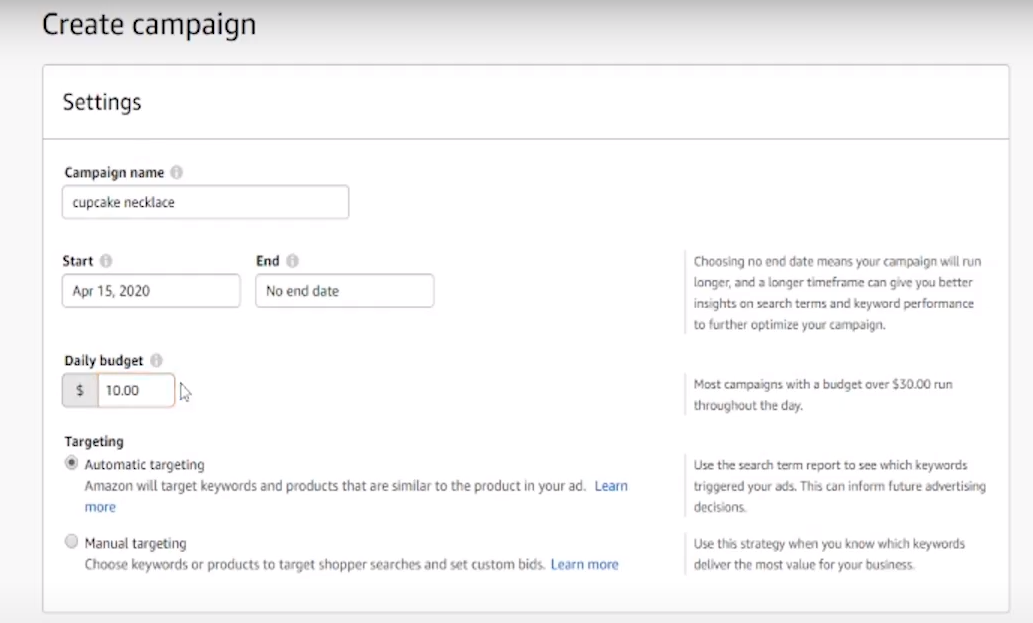
Once you’ve run your first campaign for a few days, you’ll get a pretty clear picture of which keywords are profitable for your product and which ones aren’t. You’ll then be able to remove the keywords that are costing you money and double-down on the ones that are more profitable.
The more often you rinse and repeat this process, the more profitable you’ll become. I’ll show you exactly how that’s done in just a minute.
Now, you can scroll down to the bidding section. where you’ll see dynamic bids down only, which is exactly what we want to select.
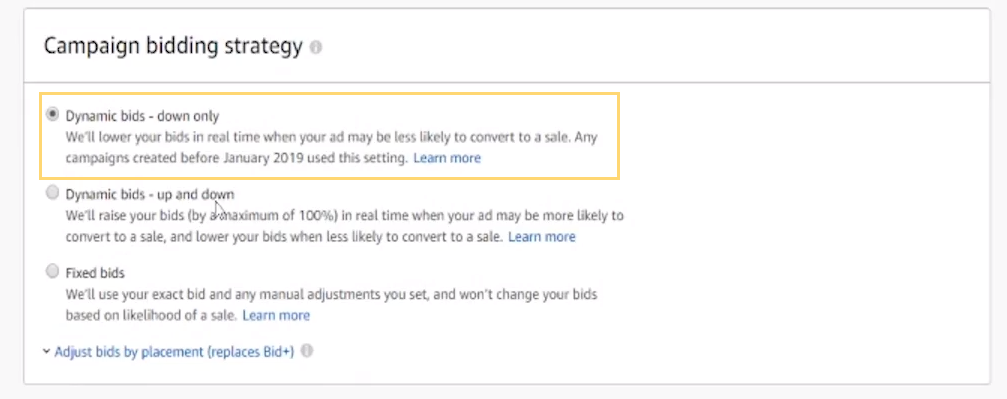
When selecting dynamic bids down only, the Amazon algorithm is going to lower your bids in real time, whenever your ad is less likely to convert. This is great, because you’ll only be spending real money when there’s a higher chance of making a sale.
Alright so once you’ve got that set up, you can head over to Ad Group and just make it the same as your campaign name. So I’m going to type in “cupcake necklace” again.

Next, you want to assign your product to the campaign, which for this example is going to be (you guessed it) my cupcake necklace.
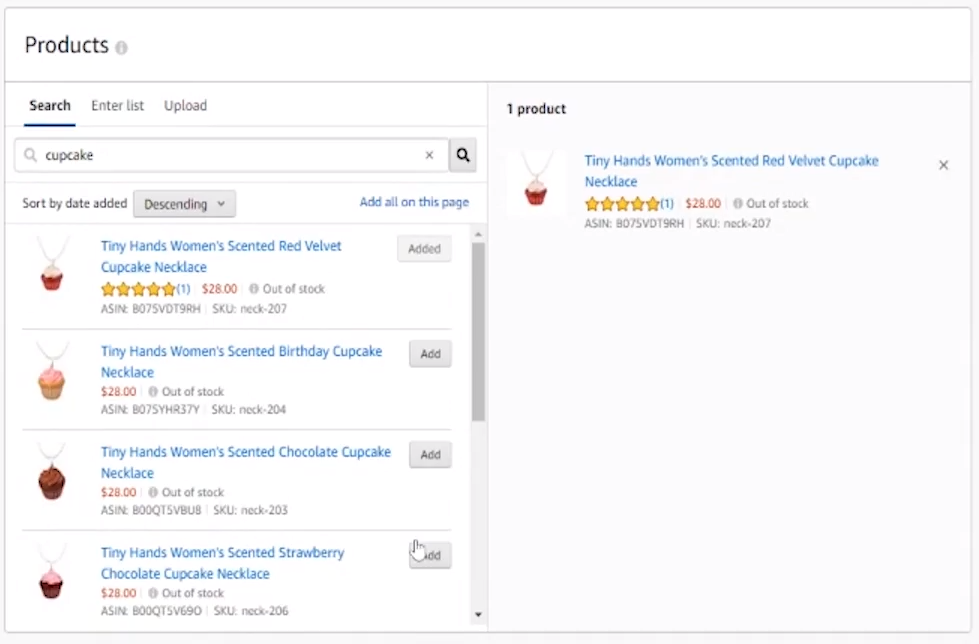
Before we move on to your default bid amount, let me explain how this works: The Amazon ads algorithm functions a lot like an auction. So for example, if I were the only person bidding for the keyword “cupcake necklace”, I would have no competition at all. This means I could bid as little as 2 cents and still easily end up on the top of the page in search results.
If however there was another person bidding 20 cents on the same keyword, their ad would probably show up 10 times more often in search results and definitely rank higher up on the page than mine.
Thankfully, Amazon gives you an indication of how much people are typically bidding for this keyword. Now, while they give you an average suggestion, I suggest bidding towards the upper end of the range, to make sure you’re outbidding the majority of your competitors. So I’m going to type in $1.27.

We’ll leave the negative keywords section blank for now, but we’ll be getting back to it later, once we’ve gathered a bit of data from your first campaign.
Alright, so once you’ve set up your bid, you can click launch campaign and then let it run for at least 5-6 days.
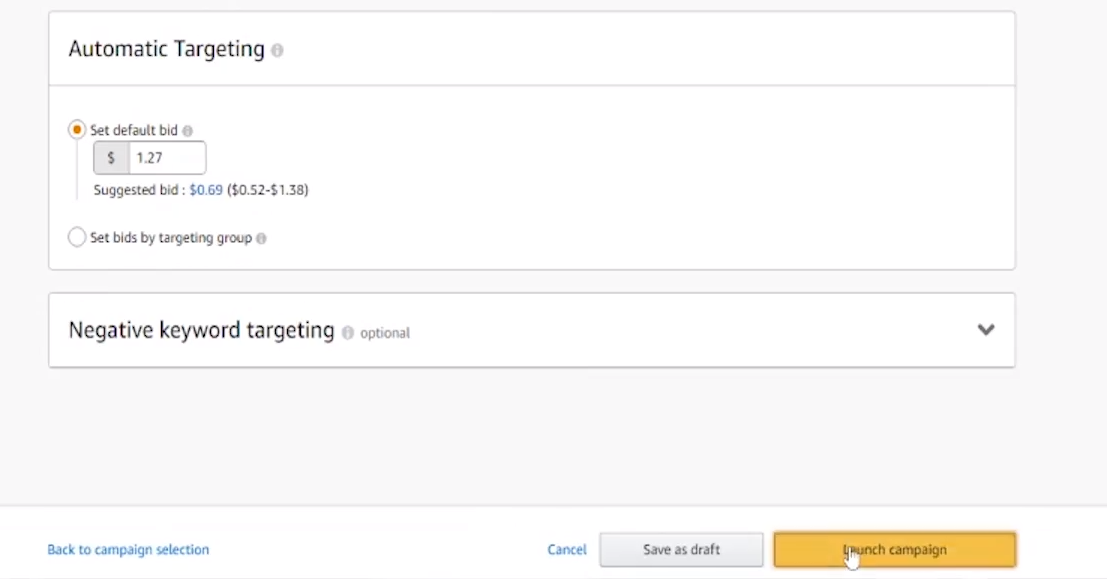
If your product pictures, title and description was pretty good, you’ll have gathered a good amount of data and hopefully made a few sales in the process as well.
Generating a Search Term Report
Next you’ll want to generate and download your search term report to see how you’ve done. Simply click on reports, and select advertising reports.
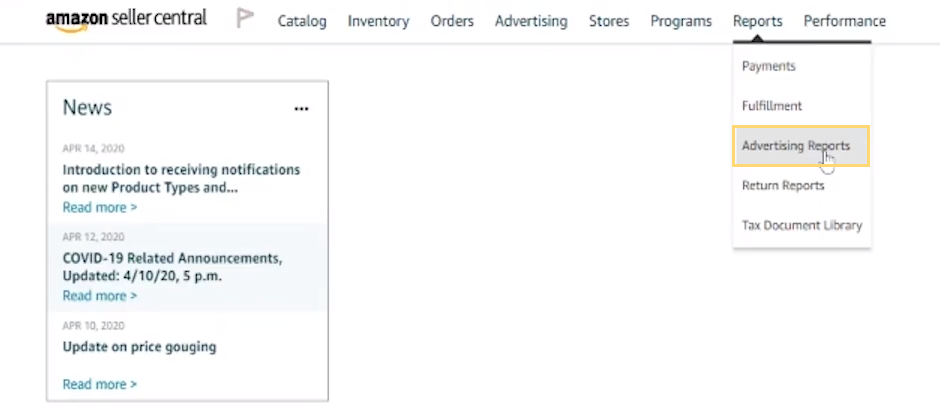
Click on Create Report.

Now, for report type, you’ll want to select search term and select the period of last month, which will include the last 5-6 days for sure. Then, click on create report.
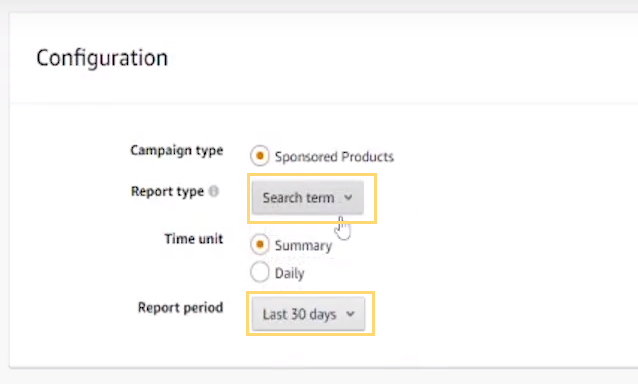
As soon as it’s done generating your report, you’ll be able to download an excel spreadsheet.
So this is what the excel spreadsheet looks like.

Making Sense of Your Report
Now I know there’s a lot of metrics to look at, but we only need to know about a few to make the most out of our ads.
We have the customer search term column, which is what people are actually searching for when they see your ad. We also want to look at is the ACoS column, which is short for Advertising Cost of Sales.
This is probably the most important column, because it tells you which keywords are profitable and which ones aren’t.
Let’s pull up our example of the cupcake necklace again. The necklace cost $30, but after materials and labor and Amazon fees, we were left with $19, which means we have a 63% profit margin. So any keywords that gave us an ACoS below 63% are profitable. Anything higher than 63%, and we’re overspending on ads and not making any money.
We, of course, don’t want to max out at 63%, so you’ll want to keep around any ads with ACoS of under 63%. The lower the better.
Now, our next step is to extract all the profitable keywords, so we can double down on them, and tell Amazon to stop targeting the ones that are either costing us too much money or not making us any money at all.
These are what we call negative keywords and you can easily find them by filtering the ACoS column from highest to lowest.
In our case, negative keywords are any that go over 63%, or just aren’t producing any sales at all. Now even if a keyword’s ACoS is 62% and it’s making you only 1% profit, you might still want to keep it! That’s because any sales help your original product listings rank higher organically, so that even when your ad isn’t showing, your original product listing is still ranking higher in the actual search results.
Ok, so once you’ve selected all the negative keywords, you want to go back to your campaign in Amazon’s seller central, head over the negative keywords tab and click on add negative keywords.
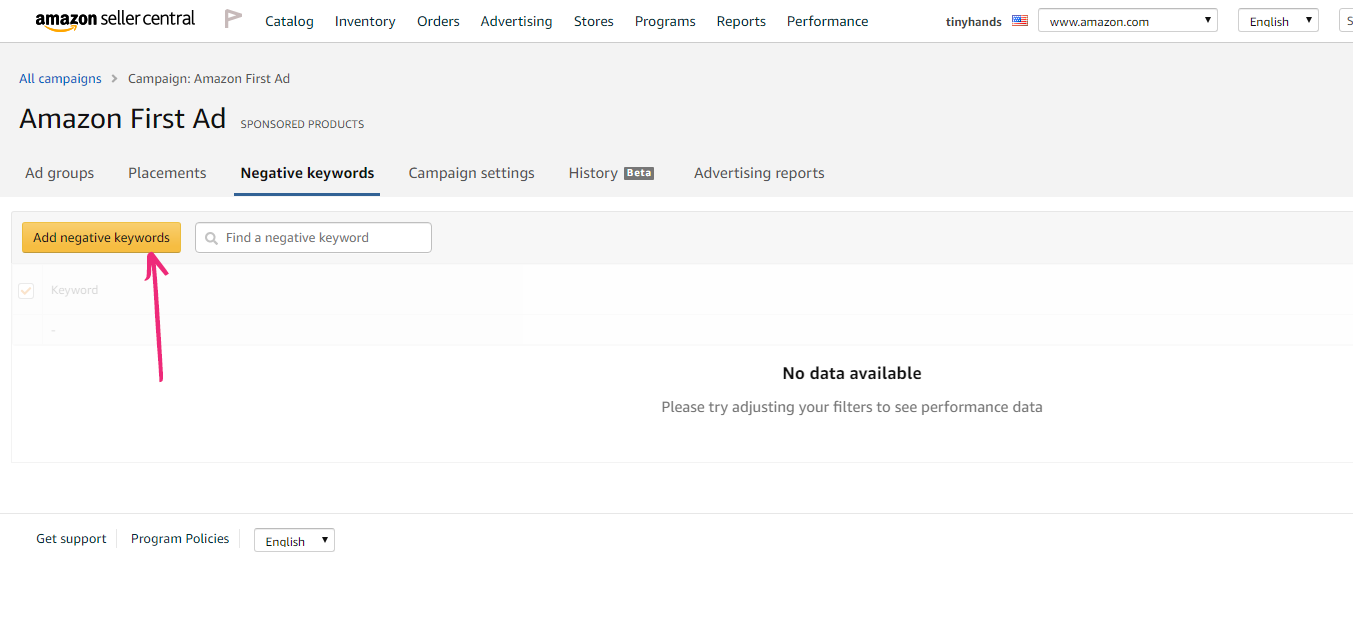
This will give you a list where you can put all the negative, non-profitable keywords you don’t want Amazon to target anymore, before refreshing your campaign.
With those out of the way, Amazon is going to put your budget exclusively towards the remaining profitable keywords, which will make for a more targeted campaign and help you make more money from your ads.
Now all you need to do is check back in another 5-6 days to see how those keywords performed, and just keep rinsing and repeating the same process until you’ve honed in on the best keywords for your niche.
And that’s pretty much all you need to do. Amazon ads don’t have to get any more complicated than that. You can choose to run separate campaigns for your different products, or group multiple similar products under the same campaign.
If you had three different types of cupcake necklaces, you could try and group them all together. It’s really up to you.
You may be profitable right away or it could take a bit of an initial investment, but if you stick with it, you’ll eventually be left with a list of highly profitable keywords that you can use to target your audience directly.
That’s when you can switch over to Amazon’s manual campaigns and use your targeted keywords to get in front of your perfect customers and begin to boost your profits faster than ever.
I hope you got a ton of value from this post and learned how you can use Amazon’s incredibly powerful advertising tools to boost your handmade business. Like I said, you don’t need to be a marketing genius. All it takes is a bit of basic math and consistency.
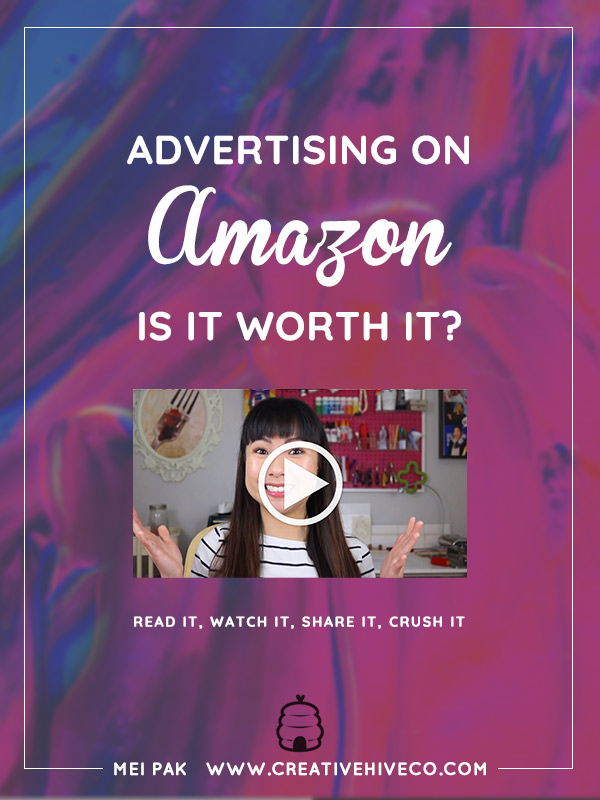
Leave a Comment
Liked this article? Share it!
Unlock a Profitable Handmade Business
in Just 12 Weeks Without Using Etsy
or Social Media
FREE WORKSHOP
This workshop is for anyone who makes and sells a handmade or physical product, including jewelry designers, artists, paper designers, bath & body product makers and more!
What You'll Discover
The #1 mistake people make with Etsy & social media that causes shops to FLOP
The secret to making it with your handmade shop so it's no longer just a hobby
How to make sales in your handmade shop with ease so you can finally get to 6-figures
TAKE ME THERE
Your email address will not be published. Required fields are marked *
Leave a Reply Cancel reply
About
Blog
A Sale A Day
Student Login
Free Class
Contact
Terms
Become A Student
Watch On YouTube
Student Reviews
See My Handmade Shop!
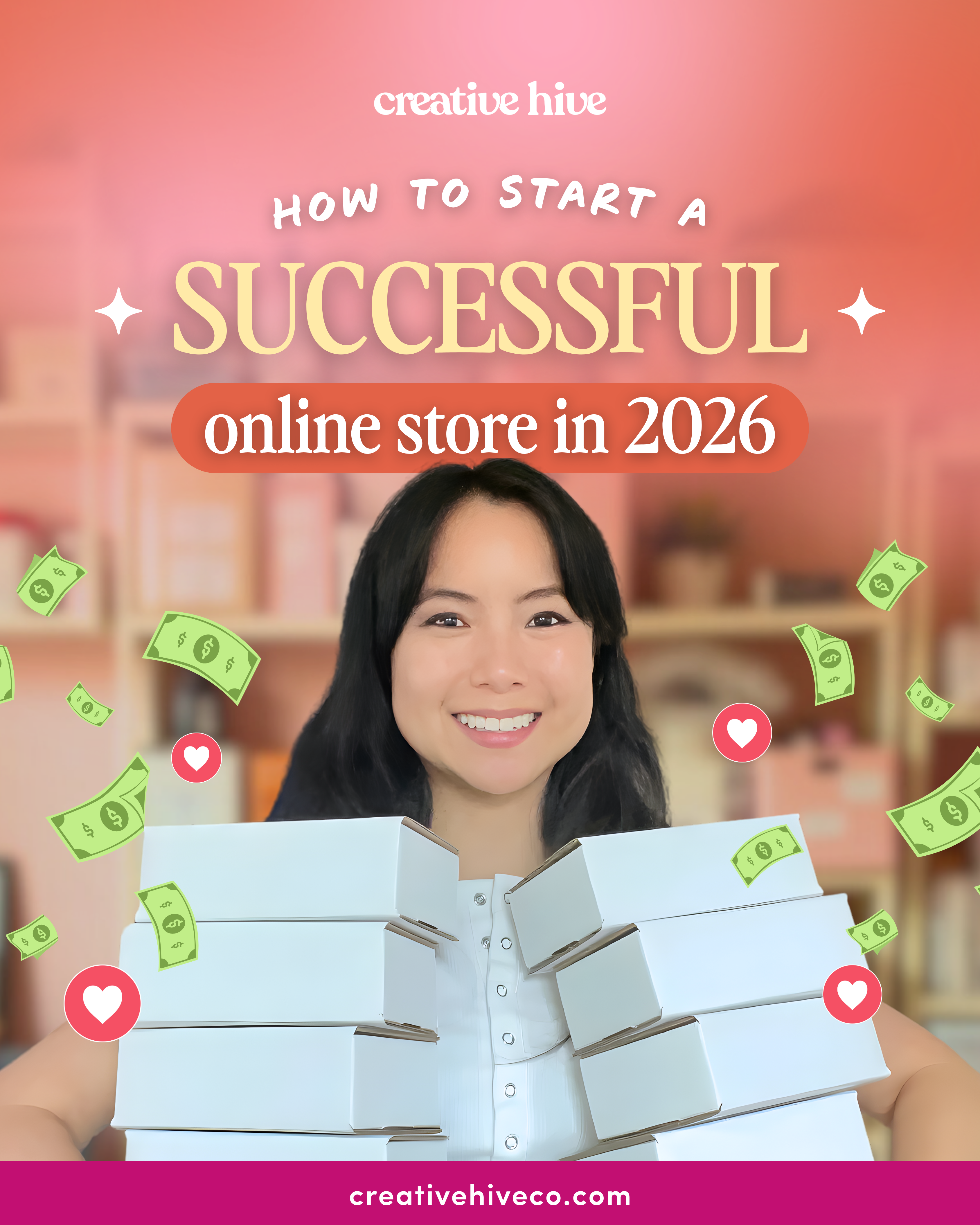
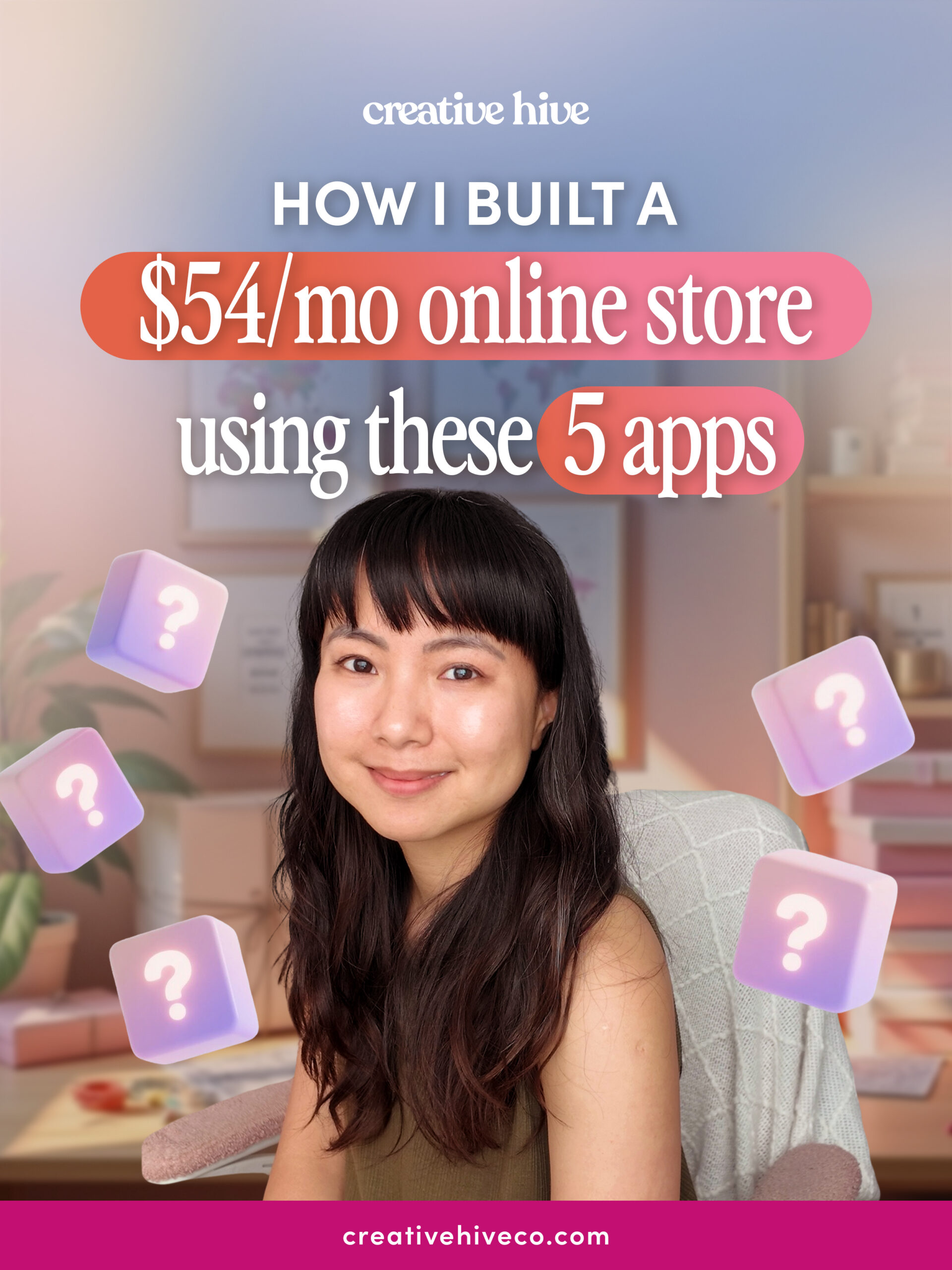

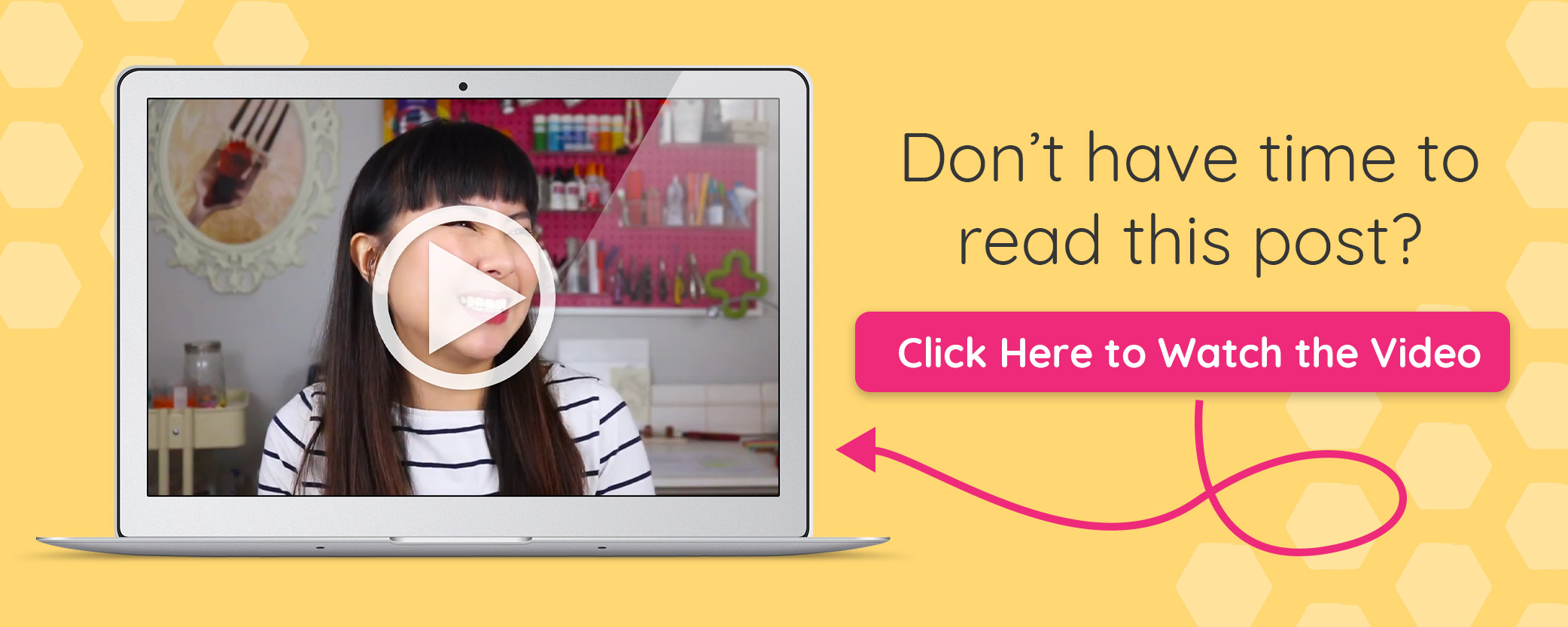
Absolutely! Advertising on Amazon is worth it for boosting visibility and driving sales. With targeted PPC campaigns, you can reach potential customers actively searching for your products. The data-driven insights help optimize your strategy, improve rankings, and ultimately increase your ROI. It’s a smart move for growing your Amazon business. For more valuable resources and services similar to our discussion, explore https://bawejamedia.com/